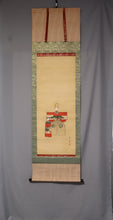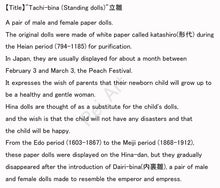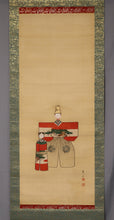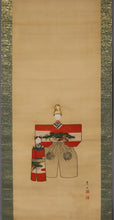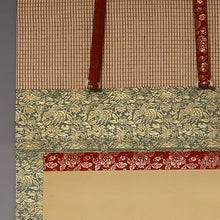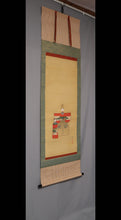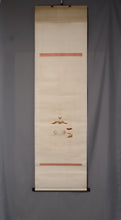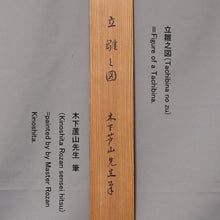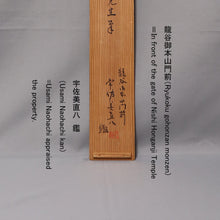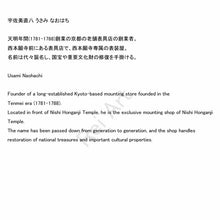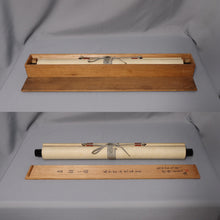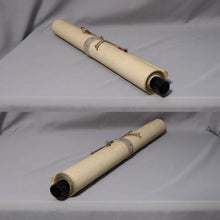
For all customers
※Products that use ivory will be changed to other materials and shipped.
This is because the Washington Convention currently prohibits the export and import of ivory products in all countries including Japan.
※you may be charged Value Added Tax (VAT) by the state when you receive your purchased artwork.
(Amount according to the laws of each country.Nearly 20%-30% of the purchase price and shipping costs)
Art work details
Fixer du poids
Cette pièce pèse 0,9 kg et sera expédiée en taille 80.
Matériel
Pigments japonais sur la soie
Taille
Dans l'ensemble: la largeur verticale de 180 × 50,2 cm * ne comprend pas les extrémités des rouleaux.
(Le travail: vertical 101,4 × largeur 39,8 cm)
Condition
・ Il y a des brûlures, des taches, des rides, des flotteurs sur le papier japonais à l'arrière de la couverture.
·Il y a quelques brûler, taches, ridessur l'image.
・ Il y a un léger pelage de pigment blanc.
・ Il y a des brûlures, des rides, une chaîne dans le montage.
Remarques
Les extrémités du rouleau sont la laquerware.
・ Usami Naohachi a évalué la pièce et a signé la boîte.
Matériaux pour le montage
・ Tous sont en soie.
Autre
** Il y a une note sur les restrictions d'expédition et la TVA. Veuillez vérifier avant l'achat. **
* Il peut y avoir une légère différence de couleur entre la photo et le produit réel.
Biographie
Kinoshita Rozan (? -?)
・ La biographie de l'auteur est inconnue.
Un mot du magasin
Il s'agit d'une peinture de poupées Hina présentées lors du festival japonais Peach le 3 mars.
Contrairement aux poupées Hina modernes, le modèle du tableau est une première poupée Hina appelée Tachibina.
Les marges de la peinture ont des rondins, des taches, des rides, etc. en raison de son âge.
La peinture blanche sur le visage a également du pelage.
Cependant, les autres couleurs conservent la bonne coloration des anciens pigments.
Le montage est fait de magnifique soie de haute qualité, comme il convient à une occasion festive.
De l'intérieur, il y a des modèles de camélia, de phénix et de réseau.
Il est probable que Usami Naohachi, l'artiste croissant qui a évalué ce travail, a fait le travail.
Par conséquent, même des décennies après sa montée, le reste de la surface reste en bon état avec seulement un peu effiloché des fils.
Aucun détail de l'artiste, Kinoshita Rozan, n'a été trouvé dans la littérature.
D'après le nom, il semble qu'il était lié au peintre d'Osaka Kinoshita Roshu (1807-1879).
Signification principale
"Tachi-bina (poupées debout)"
Une paire de poupées en papier mâles et féminines. Les poupées d'origine ont été faites de papier blanc appelé Katashiro (形代) pendant la période Heian (794-1185) pour la purification. Au Japon, ils sont généralement exposés pendant environ un mois entre le 3 février et le 3 mars, le Peach Festival. Cela exprime le souhait des parents que leur nouveau-né deviendra une femme saine et douce. Les poupées Hina sont considérées comme un substitut des poupées de l'enfant, et le souhait est que l'enfant n'aura aucune catastrophe et que l'enfant soit heureux. De la période Edo (1603-1867) à la période Meiji (1868-1912), ces poupées en papier ont été affichées sur le Hina-Dan, mais ils ont progressivement disparu après l'introduction de Dairi-Bina (内裏 雛), une paire de mâles et Les poupées féminines faites pour ressembler à l'empereur et à l'impératrice.
Precautions
[Important Notice]
Please pay attention to the following points before buying.
●We will ship from Japan to the rest of the world.
As a result, you may be charged Value Added Tax (VAT)
by the state when you receive your purchased artwork.
(Amount according to the laws of each country.
Nearly 20%-30% of the purchase price and shipping costs)
●In addition, please note that we are not able to "under-value" the purchase price at the time of shipping.
●※Recently, there has been an increase in the number of cases
where packages have not been delivered to Italy.
For Italian customers, we may ask for "codice fiscale" after
purchase. Please be forewarned.
●Currently, the Washington Convention prohibits the export and import of ivory products in all countries including Japan. If ivory is used as the material in the hanging scroll / Bokuseki work, we will change it to another material and ship it.
Thank you for your understanding in advance.
About shipping
The standard shipping fee is as follows.
Currency unit is Japanese Yen.
If you have any questions, please contact us.
EMS
| EMS | |||||
|---|---|---|---|---|---|
| Maximum weight | Area | ||||
| A | B | C | D | E | |
| Asia | Asia2 | Europe, Oceania, Middle East, North Americ | North America | Africa | |
| 0.5kg | ¥1,450 | ¥1,900 | ¥3,150 | ¥3,900 | ¥3,600 |
| 0.6kg | ¥1,600 | ¥2,150 | ¥3,400 | ¥4,180 | ¥3,900 |
| 0.7kg | ¥1,750 | ¥2,400 | ¥3,650 | ¥4,460 | ¥4,200 |
| 0,8kg | ¥1,900 | ¥2,650 | ¥3,900 | ¥4,740 | ¥4,500 |
| 0.9kg | ¥2,050 | ¥2,900 | ¥4,150 | ¥5,020 | ¥4,800 |
| 1.0kg | ¥2,200 | ¥3,150 | ¥4,400 | ¥5,300 | ¥5,100 |
| 1.25kg | ¥2,500 | ¥3,500 | ¥5,000 | ¥5,990 | ¥5,850 |
| 1.5kg | ¥2,800 | ¥3,850 | ¥5,550 | ¥6,600 | ¥6,600 |
| 1.75kg | ¥3,100 | ¥4,200 | ¥6,150 | ¥7,290 | ¥7,350 |
| 2.0kg | ¥3,400 | ¥4,550 | ¥6,700 | ¥7,900 | ¥8,100 |
| 2.5kg | ¥3,900 | ¥5,150 | ¥7,750 | ¥9,100 | ¥9,600 |
| 3.0kg | ¥4,400 | ¥5,750 | ¥8,800 | ¥10,300 | ¥11,100 |
| 3.5kg | ¥4,900 | ¥6,350 | ¥9,850 | ¥11,500 | ¥12,600 |
| 4.0kg | ¥5,400 | ¥6,950 | ¥10,900 | ¥12,700 | ¥14,100 |
| 4.5kg | ¥5,900 | ¥7,550 | ¥11,950 | ¥13,900 | ¥15,600 |
| 5.0kg | ¥6,400 | ¥8,150 | ¥13,000 | ¥15,100 | ¥17,100 |
Country classification
A: Asia
China, South Korea, Taiwan
B : Asia
Hong Kong, Macau, Singapore, Thailand, Philippines, Vietnam, Malaysia
C : Europe, Oceania, Middle East, North America
Austria, Belgium, Bulgaria, Croatia, Czech Republic, Denmark, Estonia, Finland, France,
Germany, Hungary, Iceland, Ireland, Italy, Latvia, Lithuania, Luxembourg, Netherlands, Norway, Poland,
Portugal, Slovenia, Spain, Sweden, Switzerland, the United Kingdom, Australia, Canada, Mexico, New Zealand,
Romania, Greece
D : North America
United States of America
E : Africa
South Africa












